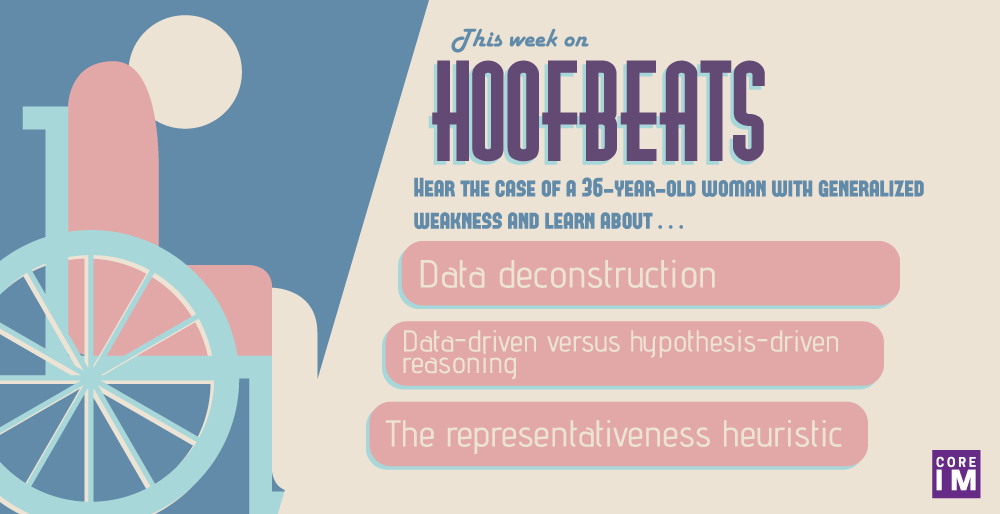Podcast: Play in new window | Download
Subscribe: RSS
 By John Hwang MD, Cindy Fang MD, Neha Sathe MD,  Michael P. Janjigian MD || Audio Editing and Graphic by Amy Ou, MD
By John Hwang MD, Cindy Fang MD, Neha Sathe MD,  Michael P. Janjigian MD || Audio Editing and Graphic by Amy Ou, MD
Time Stamps
- Part 1 Case (2:05)
- Framing bias (7:07)
- Data-driving reasoning  (11:48)
- Hypothesis-driven approach (12:38)
- Periodic paralysis syndromes (16:08)
- Representativeness heuristic (17:26)
- Part 2 Case (20:51)
- Pivot Points (31:36)
- Diagnosis (35:55)
- Take aways (37:20)
Subscribe to CORE IM on any podcast app! Follow us on Facebook @Core IM || Twitter @COREIMpodcast || Instagram @core.im.podcast. Please give any feedback at COREIMpodcast@gmail.com.
Show Notes
- A clinician employing “data-driven reasoning†(“working forwardsâ€) starts with raw clinical data and tries to arrange them into meaningful patterns to build hypotheses about the patient’s illness.
- A clinician employing “hypothesis-driven reasoning†(“working backwardsâ€) starts with a clinical problem, generates a series of hypotheses about the patient’s illness, then tests each of these against the available clinical data.
- Patients with hypokalemic periodic paralysis syndromes suffer episodic weakness due to massive intracellular shifts of potassium, often triggered by periods of stress or exercise; they can be entirely asymptomatic between episodes.
- The representativeness heuristic is a mental shortcut in which a clinician judges the probability of a diagnosis based on the similarity of the patient to the clinician’s mental picture (i.e. stereotype) of that diagnosis.
- Base-rate neglect refers to the tendency of clinicians to rely on information specific to a case (e.g. using the representativeness heuristic) to judge the likelihood of a given diagnosis, while ignoring the actual prevalence of that diagnosis.
- It is not uncommon for patients with Sjogren’s syndrome to develop renal manifestations of their disease; this can take the form of subclinical lab abnormalities, nephrogenic diabetes insipidus, progressive renal insufficiency, and chronic tubular or interstitial nephritis, with or without renal tubular acidosis.
- The combination of hypokalemia and non-anion gap metabolic acidosis is a diagnostically meaningful pattern, characteristic of two disease processes: diarrhea and renal tubular acidosis.
References
- Patel VL, Arocha JF, Kaufman DR. Diagnostic Reasoning and Medical Expertise. Psychology of Learning and Motivation – Advances in Research and Theory. 1994;31(C):187-252. Available from, DOI: 10.1016/S0079-7421(08)60411-9.
- Kassirer JP, Kopelman RI. Learning Clinical Reasoning. Baltimore: Williams and Wilkins, 1991.
- Zayac A, Shah R, Shah M, Umar J, Bansal N, Dhamoon A. Thyrotoxic hypokalemic periodic paralysis. QJM: monthly journal of the Association of Physicians 2016;109:613-4.
- Kahneman D, Tversky A. On the psychology of prediction. Psychological Review 1973;80:237-51.
- Arocha JF, Wang D, Patel VL. Identifying reasoning strategies in medical decision making: a methodological guide. Journal of biomedical informatics 2005;38:154-71.
- Francois H, Mariette X.  Renal involvement in primary Sjögren’s syndrome.  Nat Rev Nephrol.  2016 Feb; 12(2):82-93.
- Kronbichler A, Mayer G. Â Renal involvement in autoimmune connective tissue diseases. Â BMC Med. 2013; 11(95).
